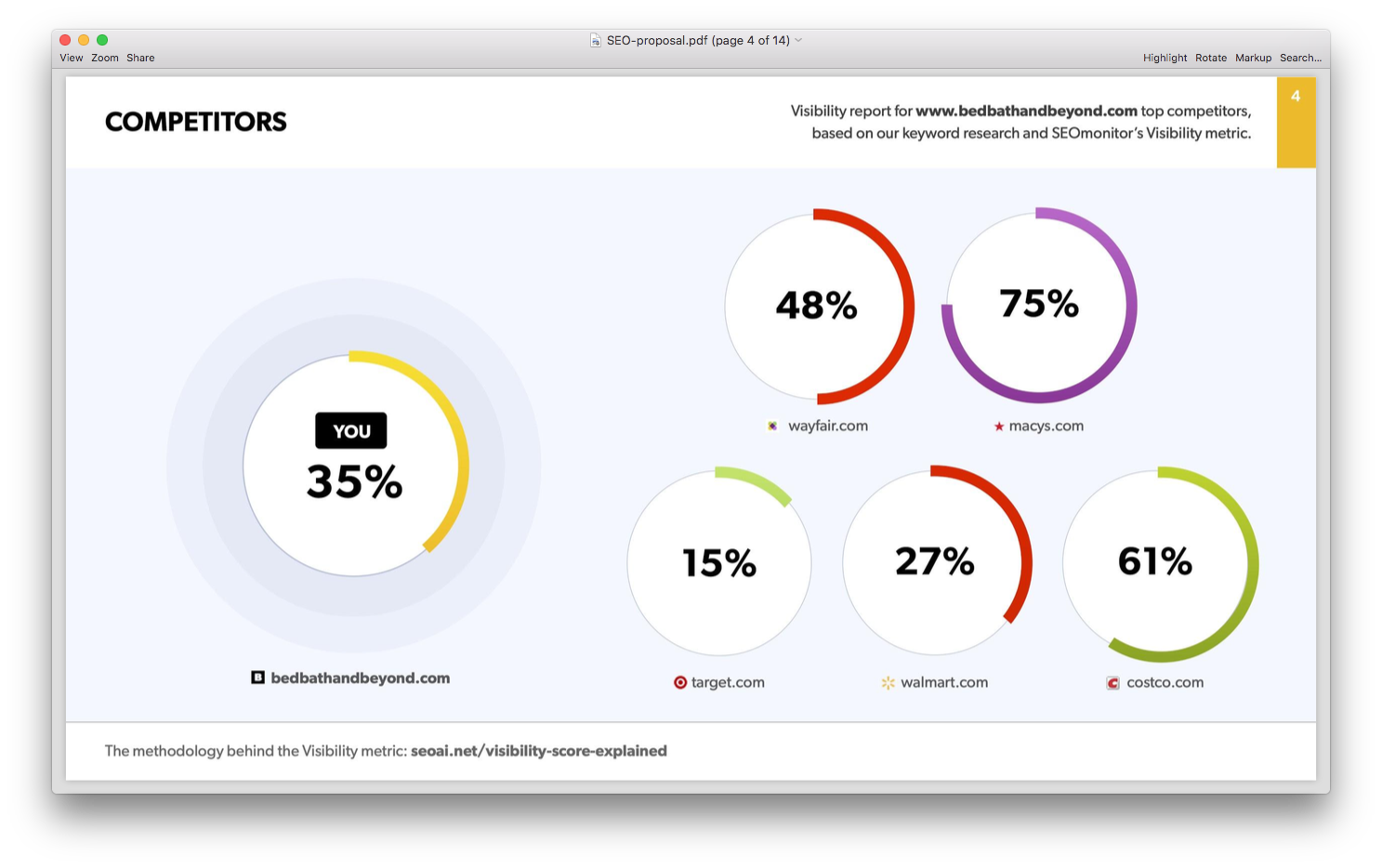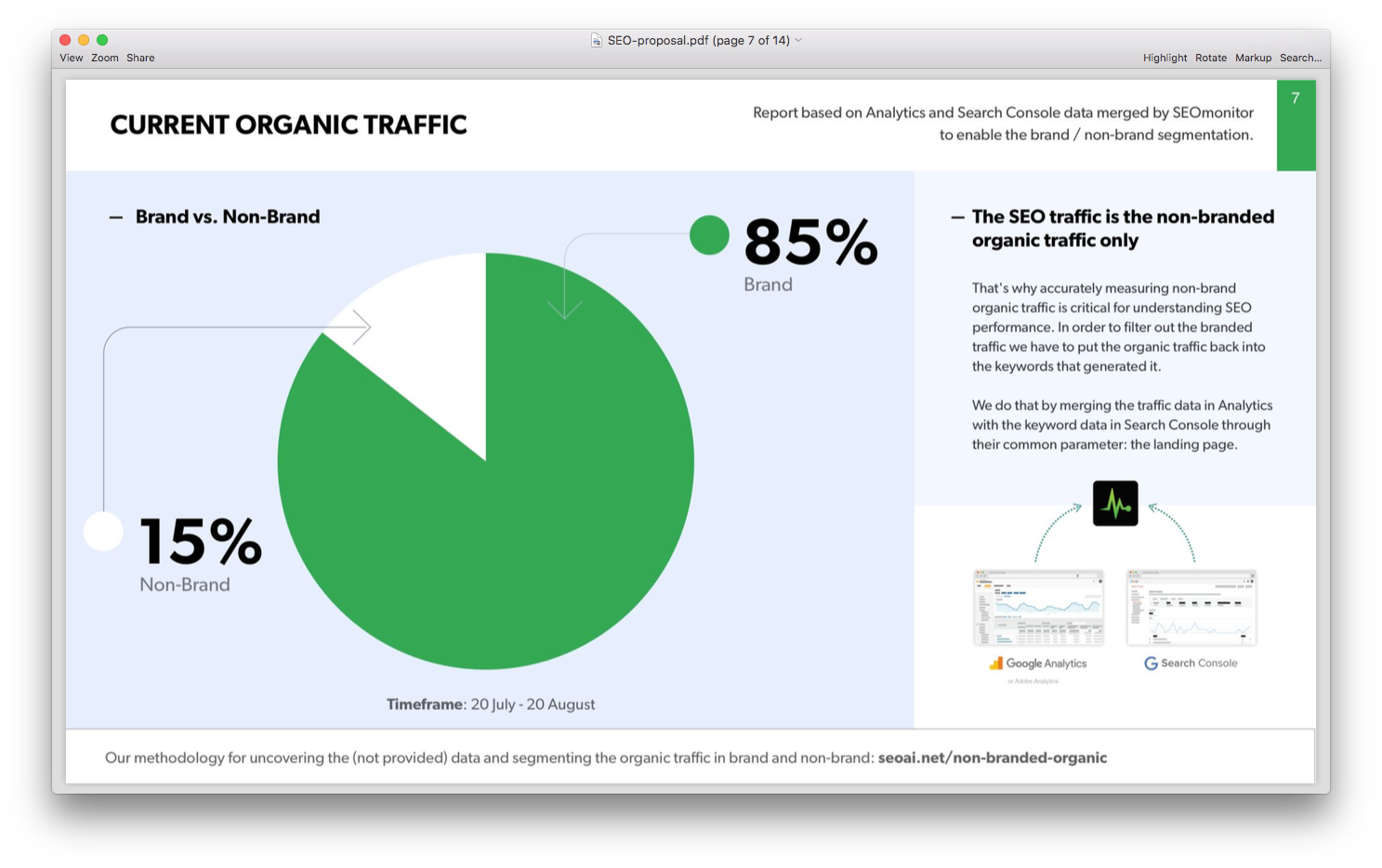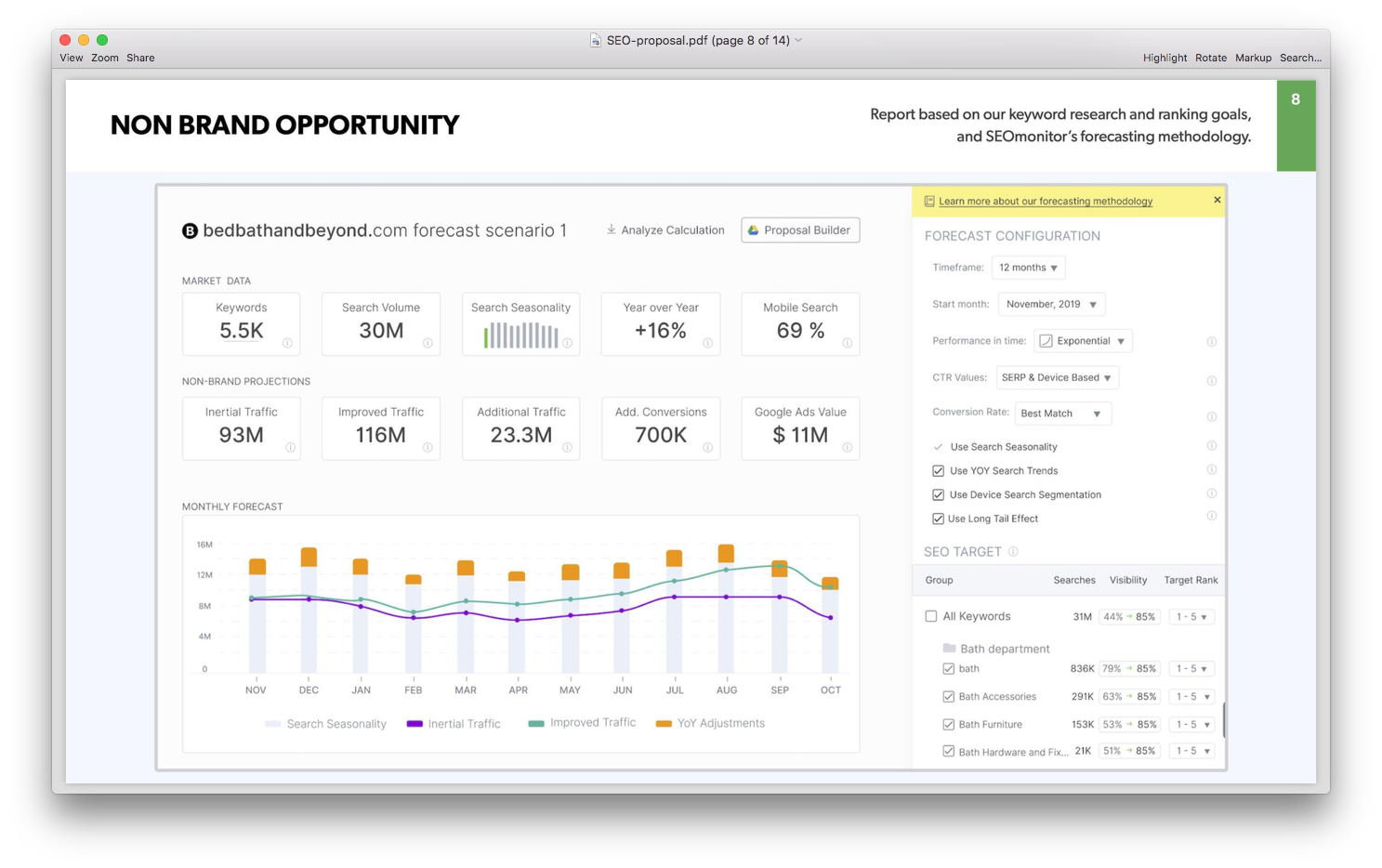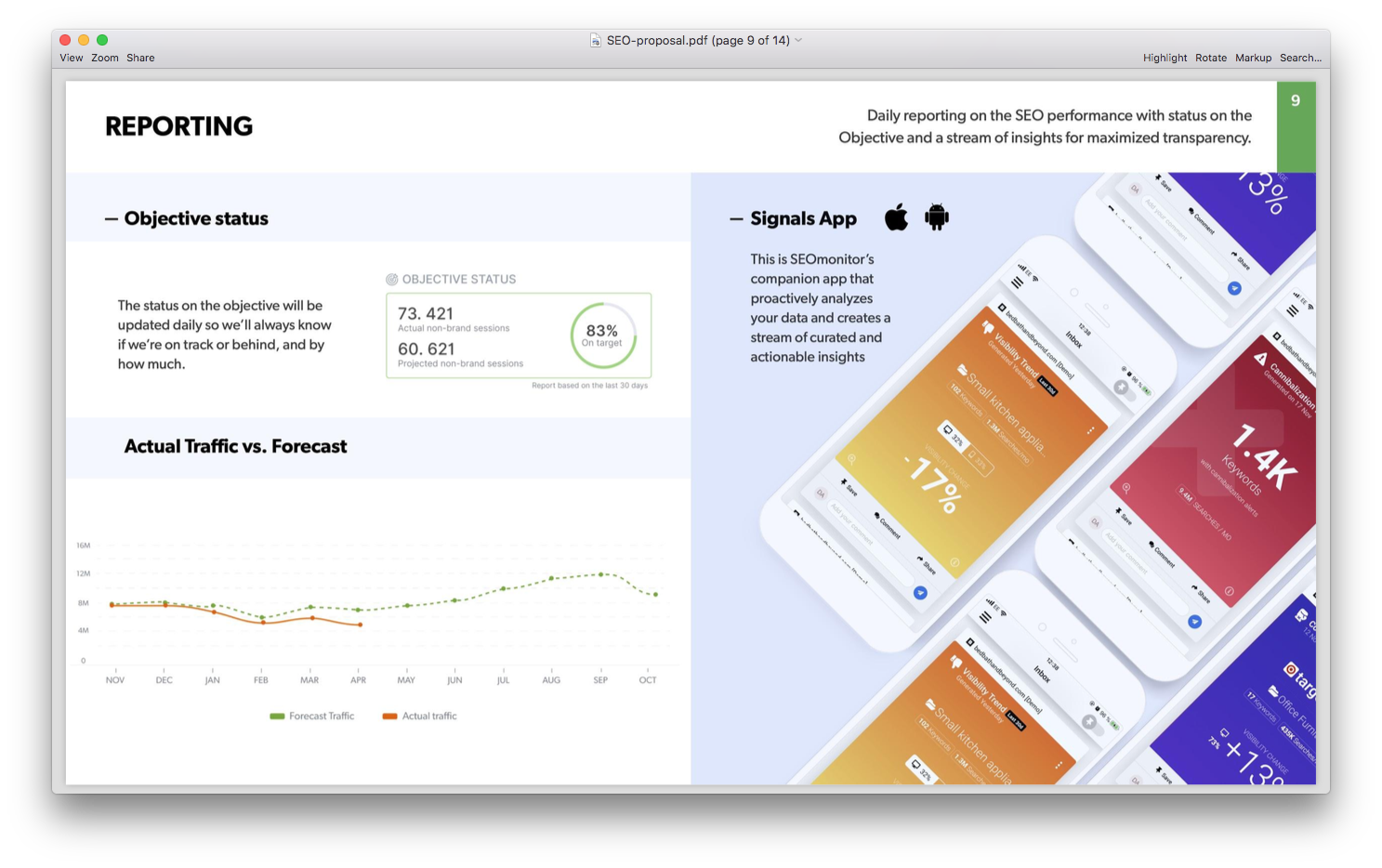02 Dec SEO Proposals: Their Particular Challenge & How to Avoid Getting a Silent No via @seomonitor
Competitor Overview
Customers might think of their competitors as being other companies selling similar services and products, regardless of their organic visibility. They might even disagree that a particular website or company is in their industry, but you have data on your side. You’ve selected precisely the companies that get the most impressions for the selected group of keywords – and it’s all easily verifiable by searching on Google.


The different visibility scores set the stage for what the opportunity will be. While it’s impossible to predict what the future will hold, the present results are precise.
If a competitor has already achieved success, it shows there’s a substantial opportunity.
2. Establish the Truth on the Current SEO Performance by Splitting the Organic Traffic in Brand and Non-Brand
The outcome of SEO is the increase in organic traffic. This makes many people turn towards the organic traffic figure whenever they want to measure SEO performance.
The total number of organic traffic is composed of both brand and non-brand organic visits. Still, it is only the non-brand traffic that is connected with, and dependent on, search engine optimization.
Your customer might intuitively realize this, but they didn’t have the tools to be able to study the data. If you split the two, you focus the evaluation process on SEO, and it shows that you would not take credit for marketing activities that were already going on, and so removing another fear that could make the customer doubtful.


Also, it might be the first time the customer can put their finger on how much their branding drives their income, a question they might have struggled with for a long time.
3. Present a Realistic Forecast That Can Be Understood & Verified
Estimating Impact in Terms of Clicks and Conversions Instead of Rankings
From a customer perspective, all of the improvements in visibility have just one final goal – an increase in their business performance.
Clicks, e-commerce transactions or goals are the way businesses keep track of them. By transposing better rankings to clicks and conversions, you tie the SEO campaign to the reality of running a business.
Decoding the impact of rank changes into clicks and conversions would look like a simple formula for a customer at first.
Still, when taking into account search volumes, year over year trends that influence the past data and dynamic changing CTRs, you show much work and thought goes into the process.
But to do that, you need to get into an even lower layer — the way Google displays results for each keyword and how changes in search features influence click-through rates.
Not only that, but the advent of mobile brings even more pieces to the puzzle.
The “ten blue links” have diminished in favour of a mix between search features and organic results. For example, a search for “hotels in Paris” would trigger Google’s hotel widget and at least two ads. It would take more than three full scrolls to get to the first organic result.


By using a variable CTR model for each SERP, you remove the possibility that the methodology could be considered oversimplified and expose the customer to the complexities of modern organic optimizations.
By adding monthly swings in search volume and year-over-year trends, you set the building blocks for a data-driven, comprehensive forecast.
Highlight How Their Traffic Would Look like With & Without the SEO Campaign
Unless your customers have just launched their website, they already rank in search engines.
By going the extra mile and first creating and presenting a forecast based on their current traffic and the search trends that might influence them, you lay out a foundation of transparency and easily researchable assumptions.
Highlighting the difference between existing, projected and additional traffic and conversions you remove one last piece of doubt – What might happen if I won’t go through with the SEO campaign?
Setting Expectations and Aligning SEO with the Customer’s Business Projection
While some customers know that SEO is more of a marathon than a sprint, for others, it may be their first foray in attempting to improve visibility.
By acknowledging that the first months would bring less impact, but it picks up as the campaign progresses, you are transparent from the start.


A twelve-month forecast allows customers to be able to take their sales projections and fit them on top of the SEO opportunity.
Instead of treating SEO as an independent tactic, they can now imagine the campaign as an essential activity to their day-to-day business operations.
Including seasonality allows for better inventory planning and proves once more that you’re committed to their long term success.
They also get to learn about consumers’ habits and maybe, in the future, rely even more on search data when making a business decision.
4. Compare the SEO Budget to the Equivalent in PPC
Is the SEO campaign worth it?
This question might go through someone’s mind when having to make the final decision.
By bringing an external source of truth in the form of how much it would cost to run a paid search campaign on the exact keyword portfolio, you highlight how valuable it is for other companies to grab the first results.
It allows the customer to perform their independent research and build more trust in the projected outcome. Not only that, but they now have a point of reference for your pricing as well.
5. Convey Transparency by Discussing Performance Tracking
As you have now navigated the ins and outs of the forecast, there’s still one more thing that might get the customer to find themselves in a loop.
Can they trust your agency on delivery? Would they be able to check the progress by themselves?
They can’t just load up their analytics account and see the impact – the results are a mix between branded and non-branded keywords.
You could provide a detailed explanation of how reporting will run in relationship with the set goal and what goes into the metrics that describe their visibility.


Taking it a step further and including the objective in the contract can remove any fear they might have.
It’s bold, but isn’t it worth it to have your agency’s day-to-day operations aligned with your customer’s results?
How to Help Your Customers Say a Loud Yes Instead of a Silent No?
Remove doubts that could form in their mind, by explaining each hypothesis and backing it up with evidence, by going through the following:
- Show a deep understanding of the industry.
- Establish the truth on their current SEO performance by splitting brand and non-brand traffic.
- Present a realistic forecast that can be understood and verified.
- Compare the SEO budget to the equivalent in PPC.
- Convey transparency by discussing performance tracking
Meticulously going through all of these steps is hard. We get that. That’s why we’ve launched a new version of our “Search Awards” winning SEO forecasting module.
It helps you along each of these actions, except for one. The hangover you get after celebrating your 10th closed deal in a single month.
Our forecasting methodology has been successfully used for more than four years, by hundreds of clients, to set realistic objectives and improve their pitches. This is why we’ve gone a step further.
We created an SEO proposal builder that leverages data from SEOmonitor, with the simplicity of Google Slides and gives real-world examples from other SEO agencies around the world, in an intuitive drag-and-drop interface.
But that’s only a part of what we do. We’ve designed SEOmonitor to help you acquire, manage and retain more customers for your agency.
Join us, and hundreds of SEO agencies clients, in the journey of bringing more transparency and measurability to the SEO industry. Click here for a trial that doesn’t ask you for a credit card, but gives you full access to the platform.
*TOP TIP: How to Follow-Up Without the Awkwardness
Instead of just asking busy customers if they had time to review your proposal, why not take a bit of time to go through their existing organic industry landscape and look for important changes that they may not even know about – Yet!
With Signals, you can easily spot those insights that would help you re-open the conversation with your indecisive customers.
Sorry, the comment form is closed at this time.